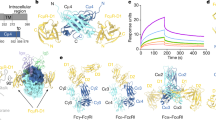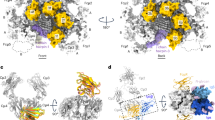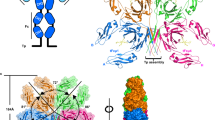Abstract
Immunoglobulins have been identified as membrane-bound molecules on the surface of B lymphocytes and as secreted products of plasma cells. In the case of immunoglobulin M(IgM) the carboxy-terminal sequences of the μ-chains of membrane-bound and secreted molecules differ from each other and are encoded by different exons of the μ constant region (Cμ) gene. The coding sequence for the C-terminus of the secreted μ-chain is contiguous with the 3′ end of the Cμ4 exon and separate exons downstream of Cμ4 encode the C-terminus of the membrane-bound chain1–3. Immunoglobulin D is also found membrane-bound and as a secreted molecule, and recent data indicate that the exon arrangement of the Cδ gene is in part similar to that of the Cμ gene4,5. However, the amino acid sequence analysis presented here demonstrates that in the case of IgD the C-terminus of the secreted δ-chain is encoded by a separate exon (the CδDC exon of Tucker et al.5) and not by the CδAC sequence which corresponds topographically to the sequence expressed at the C-terminus of secreted μ chains.
This is a preview of subscription content, access via your institution
Access options
Subscribe to this journal
Receive 51 print issues and online access
$199.00 per year
only $3.90 per issue
Buy this article
- Purchase on Springer Link
- Instant access to full article PDF
Prices may be subject to local taxes which are calculated during checkout
Similar content being viewed by others
References
Singer, P. A., Singer, H. H. & Williamson, A. R. Nature 285, 294–300 (1980).
Rogers, J. et al. Cell 20, 303–312 (1980).
Early, P. et al. Cell 20, 313–319 (1980).
Liu, C., Tucker, P. W., Mushinski, J. F. & Blattner, F. R. Science 209, 1348–1352 (1980).
Tucker, P. W., Liu, C., Mushinski, J. F. & Blattner, F. R. Science 209, 1353–1360 (1980).
Neuberger, M. S. & Rajewsky, K. Proc. natn. Acad. Sci. U.S.A. 78, 1138–1142 (1981).
Kehry, M., Sibley, C., Fuhrman, J., Schilling, J. & Hood, L. E. Proc. natn. Acad. Sci. U.S.A. 76, 2932–2936 (1979).
Tucker, P. W. et al. in The Lymphocytes in the Immune Response (eds Mosier, D., Klinman N., Sher, E. & Vitetta, E.) (Elsevier, Amsterdam, in the press).
Waxdal, M. J., Konigsberg, W. H., Henley, W. L. & Edelman, G. M. Biochemistry 7, 1959–1966 (1968).
Bray, G. Analyt. Biochem. 1, 279–285 (1960).
Bothwell, A. L. M. et al. Cell (in the press).
Tarr, G. E., Beecher, J. F., Bell, M. & McKean, D. J. Analyt. Biochem. 84, 622–627 (1978).
Beyreuther, K., Raufuss, H., Schrecker, O. & Hengstenberg, W. Eur. J. Biochem. 75, 275–286 (1977).
Johnson, N. D., Hunkapiller, M. W. & Hood, L. E. Analyt. Biochem. 100, 335–338 (1979).
Beyreuther, K. in Solid Phase Methods in Protein Sequence Analysis, 107–119 (Elsevier, Amsterdam, 1977).
Dayhoff, M. Atlas of Protein Sequence and Structure Vol. 5, D2 (National Biomedical Research Foundation, Washington, 1972).
Author information
Authors and Affiliations
Rights and permissions
About this article
Cite this article
Dildrop, R., Beyreuther, K. C-terminal sequence of the secreted form of mouse IgD heavy chain. Nature 292, 61–63 (1981). https://doi.org/10.1038/292061a0
Received:
Accepted:
Issue Date:
DOI: https://doi.org/10.1038/292061a0
This article is cited by
-
Drastic change in idiotypic but not antigen-binding specificity of an antibody by a single amino-acid substitution
Nature (1985)
-
The molecular biology of immunoglobulin D
Nature (1984)
-
Freeze-Etching studies of b cell membranes: recent progress
Survey of Immunologic Research (1984)
-
Unusual sequences in the murine immunoglobulin μ–δ heavy-chain region
Nature (1983)
-
Structure of genes for membrane and secreted murine IgD heavy chains
Nature (1982)
Comments
By submitting a comment you agree to abide by our Terms and Community Guidelines. If you find something abusive or that does not comply with our terms or guidelines please flag it as inappropriate.



